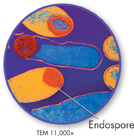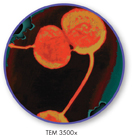Growth, Reproduction, and Recombination When a prokaryote has grown so that it has nearly doubled in size, it replicates its DNA and divides in half, producing two identical cells. This type of reproduction is known as binary fission. Because binary fission does not involve the exchange or recombination of genetic information, it is a form of asexual reproduction. When conditions are favorable, prokaryotes can grow and divide at astonishing rates. Some divide as often as once every 20 minutes!
When growth conditions become unfavorable, many prokaryotic cells form an endospore—a thick internal wall that encloses the DNA and a portion of the cytoplasm. Endospores can remain dormant for months or even years. The ability to form endospores makes it possible for some prokaryotes to survive very harsh conditions. The bacterium Bacillus anthracis, which causes the disease anthrax, is one such bacterium.

FIGURE 20–11 Endospore Formation

FIGURE 20–12 Conjugation
As in any organism, adaptations that increase the survival and reproduction of a particular prokaryote are favored. Recall that in organisms that reproduce sexually, genes are shuffled and recombined during meiosis. But prokaryotes reproduce asexually. So, how do their populations evolve?
▸ Mutation Mutations are one of the main ways prokaryotes evolve. Recall from Chapter 13 that mutations are random changes in DNA that occur in all organisms. In prokaryotes, mutations are inherited by daughter cells produced by binary fission.
▸ Conjugation Many prokaryotes exchange genetic information by a process called conjugation. During conjugation, a hollow bridge forms between two bacterial cells, and genetic material, usually in the form of a plasmid, moves from one cell to the other. Many plasmids carry genes that enable bacteria to survive in new environments or to resist antibiotics that might otherwise prove fatal. This transfer of genetic information increases genetic diversity in populations of prokaryotes.
Table of Contents
- Formulas and Equations
- Applying Formulas and Equations
- Mean, Median, and Mode
- Estimation
- Using Measurements in Calculations
- Effects of Measurement Errors
- Accuracy
- Precision
- Comparing Accuracy and Precision
- Significant Figures
- Calculating With Significant Figures
- Scientific Notation
- Calculating With Scientific Notation
- Dimensional Analysis
- Applying Dimensional Analysis





